So I’ve been looking at buying a Kimber Mountain Ascent 300 wsm, and I see people talking about learning how to shoot light rifles. What exactly does that mean? Is it just getting use to the recoil if a lighter rifle or is it the way you hold them to reduce muzzle jump, or is it something els? I have a 300 wsm and 7mm Mag now and I’m not bothered by recoil, I’m just wanting a lighter rifle.
You are using an out of date browser. It may not display this or other websites correctly.
You should upgrade or use an alternative browser.
You should upgrade or use an alternative browser.
Shooting a Kimber Mountain Ascent accurately
- Thread starter HunterMN
- Start date
Schaaf
WKR
They’re squirrely and much harder to anchor down into.
Lightweight rifles in high recoil cartridges need to be held onto...hold that forend!
I'm not a particularly advanced shooter. When I get behind my 13 pound rifle in any position, I am able to hold on target more accurately and with less deviation in the crosshairs than with my lighter rifles. This is probably indicative of a need for more practice, but with a light weight rifle I can see the reticle bounce with my heartbeat - not so with the hefty rifle. Once in position a heavier rifle is much nicer to shoot in all respects - getting it there, on the other hand, is not so nice.
Bigger, heavier rifles have a higher moment of inertia, and are less susceptible to being driven off target by shooter mechanics like breathing, apparently heartbeat in my experience, wind, trigger pull etc.
Pic: said heavy rifle on a successful elk hunt. But I was never more than a mile from the truck.
Bigger, heavier rifles have a higher moment of inertia, and are less susceptible to being driven off target by shooter mechanics like breathing, apparently heartbeat in my experience, wind, trigger pull etc.
Pic: said heavy rifle on a successful elk hunt. But I was never more than a mile from the truck.
Attachments
Lightweight rifles in high recoil cartridges need to be held onto...hold that forend!
Funny. As soon as I read the title I was going for this link.
I have a hunter in 7mm08 and I would say that even this "mild" caliber hits you by surprise in such a light gun. There is a lot of vertical rise after the shot.. it tends to jump up off the sandbag.
Therefore, not only pull it in tight to your shoulder but pull it down vertically into the rest. If possible, avoid the sling stud as a resting point.
Good news is that you can learn to shoot it well, but it will demand more practice than a heavy rifle would.
Therefore, not only pull it in tight to your shoulder but pull it down vertically into the rest. If possible, avoid the sling stud as a resting point.
Good news is that you can learn to shoot it well, but it will demand more practice than a heavy rifle would.
- Joined
- Oct 22, 2014
- Messages
- 9,904
Lightweight rifles in high recoil cartridges need to be held onto...hold that forend!
Funny. As soon as I read the title I was going for this link.
Except that there a massive amount of nonsense in that article.
I have a hunter in 7mm08 and I would say that even this "mild" caliber hits you by surprise in such a light gun. There is a lot of vertical rise after the shot.. it tends to jump up off the sandbag.
That is because it is a relatively poorly designed stock.
- Joined
- Oct 22, 2014
- Messages
- 9,904
I see people talking about learning how to shoot light rifles. What exactly does that mean? Is it just getting use to the recoil if a lighter rifle or is it the way you hold them to reduce muzzle jump, or is it sonething else?
What people say it means varies. What it actually means is that the lighter the platform is, the less the platform hides errors. This is true regardless of rifle/stock design or technique. Weight dampens movement.
The second part of why it’s harder to shoot lighter rifles; is because the lighter it is, and/or the more recoil, the more poor rifle and stock design shows itself. Again, the rifle isn’t hiding it as much. A 9lb 300WM is physically moving less than a 6lb 300WM. Any error or substandard design shows itself with the light gun. Because of the ubiquitous design of drop at heel (butt pad lower than muzzle line), the recoil force is up over the shoulder and to the right (for a RH shooter”. If the muzzle centerline is center of the shoulder, the rifle can only recoil straight to the rear if held neutrally.
To all the “37 trick moves to get my Kimber to group” people, how do you replicate that in the field, from alternate positions, under time?
JeffRaines
WKR
What people say it means varies. What it actually means is that the lighter the platform is, the less the platform hides errors. This is true regardless of rifle/stock design or technique. Weight dampens movement.
The second part of why it’s harder to shoot lighter rifles; is because the lighter it is, and/or the more recoil, the more poor rifle and stock design shows itself. Again, the rifle isn’t hiding it as much. A 9lb 300WM is physically moving less than a 6lb 300WM. Any error or substandard design shows itself with the light gun. Because of the ubiquitous design of drop at heel (butt pad lower than muzzle line), the recoil force is up over the shoulder and to the right (for a RH shooter”. If the muzzle centerline is center of the shoulder, the rifle can only recoil straight to the rear if held neutrally.
To all the “37 trick moves to get my Kimber to group” people, how do you replicate that in the field, from alternate positions, under time?
I wouldn’t say the kimbers need 37 trick moves, but you’ve got to really focus on the fundamentals. Like you said, light rifles greatly magnify any form issues, and it compounds the further you’re trying to shoot. I’d imagine it’s probably the same story for any light rifle - the tikka I have, while not as light, still requires the same routine.
MuleyFever
WKR
I have a Montana and I really have to try and concentrate to shoot it well.
JeffRaines
WKR
I would think a lot of issue stems from the fact that heavier rifles cover up more mistakes, so you get people shooting them that don’t really realize the little things they’re messing up on... then they shoot a lighter rifle and all of a sudden they can’t group for shit because all the little things are magnified, thus you have the “37 tricks” when it’s really just them having to focus on being consistent.
It’s probably not the case for all of the issues, but I’d be willing to bet it’s most of them.
It’s probably not the case for all of the issues, but I’d be willing to bet it’s most of them.
VernAK
WKR
Simple physics........shooting from a bench, pull the front sandbag back to the trigger guard or thereabouts so you have as much weigh forward as possible. I have several and they shoot just fine in the field also. My 84L MA handles like a fine bird gun......very well balanced.
AZ_Hunter_2000
WKR
- Joined
- Oct 8, 2019
- Messages
- 2,956
I just shoot my rifles the same way irregardless of weight. I also rarely touch the stock with my left hand while shooting. So far this approach works well for me.
This past Friday I took my 7# 308 Win, 8# 300 Win Mag and 9# 300 Win Mag to the range. All three consistently hit bullseyes and rang steel to mid-range distances. The 8# 300 Win Mag did give me my best 3-shot group at 100 yards of my life: 3/8" outside to outside. Been a long time since I shot my 9# 300 Win Mag and had forgotten how nice it was to shoot. If I keep that rifle, it will get a serious upgrade in optics.
I never tell myself "this is rifle X so I need to do Y differently". I just tell myself to focus on my form and process. I am human and screw the pooch periodically with all of my firearms; some days more than others. All I can hope for is to reduce the frequency by continuing to work on my fundamentals.
This past Friday I took my 7# 308 Win, 8# 300 Win Mag and 9# 300 Win Mag to the range. All three consistently hit bullseyes and rang steel to mid-range distances. The 8# 300 Win Mag did give me my best 3-shot group at 100 yards of my life: 3/8" outside to outside. Been a long time since I shot my 9# 300 Win Mag and had forgotten how nice it was to shoot. If I keep that rifle, it will get a serious upgrade in optics.
I never tell myself "this is rifle X so I need to do Y differently". I just tell myself to focus on my form and process. I am human and screw the pooch periodically with all of my firearms; some days more than others. All I can hope for is to reduce the frequency by continuing to work on my fundamentals.
menhaden_man
WKR
- Joined
- Jul 18, 2019
- Messages
- 2,187
Except that there a massive amount of nonsense in that article.
Could you point out the nonsense? Not suggesting it’s not in there, just curious what triggered such a bold statement.
The second part of why it’s harder to shoot lighter rifles; is because the lighter it is, and/or the more recoil, the more poor rifle and stock design shows itself. Again, the rifle isn’t hiding it as much. A 9lb 300WM is physically moving less than a 6lb 300WM. Any error or substandard design shows itself with the light gun. Because of the ubiquitous design of drop at heel (butt pad lower than muzzle line), the recoil force is up over the shoulder and to the right (for a RH shooter”. If the muzzle centerline is center of the shoulder, the rifle can only recoil straight to the rear if held neutrally.
True or false?: Holding the forend helps mitigate recoil impulse up and over the shoulder in “lightweight” rifle.
Lawnboi
WKR
As someone who can’t shoot light guns for crap I’m hoping to hear more from form on this one.
Had a kimber, only a 308, couldn’t shoot it for crap. Could pull off some nice three round groups from a bench but once I started shooting other positions it was ugly. Dumped it for a heavier, more forgiving gun.
The whole idea of muscle ******* the gun to control recoil just doesn't seem like a consistent approach
Had a kimber, only a 308, couldn’t shoot it for crap. Could pull off some nice three round groups from a bench but once I started shooting other positions it was ugly. Dumped it for a heavier, more forgiving gun.
The whole idea of muscle ******* the gun to control recoil just doesn't seem like a consistent approach
- Joined
- Oct 22, 2014
- Messages
- 9,904
Could you point out the nonsense? Not suggesting it’s not in there, just curious what triggered such a bold statement.
Imagine a rifle suspended in space. When it fires it will recoil nearly perfectly straight to the rear. During recoil and after recoil it will remain on target. The only reason that it doesn’t happen when humans shoot it, is due to tension that is not neutral. If you took that same rifle and fired it with the butt placed perfectly flat and perpendicular to a brick wall it will also recoil nearly straight back with a slight up and right movement to the barrel during recoil, but it will return to the target after recoil. This slight up and right happens due to the bore (recoil line) being above the center of the butt pad. Now imagine the exact same thing, but instead of a brick wall, it’s wet sand. The same thing happens. The sand gives a bit, however due to being straight behind the rifle it returns to where it started, and since no outside pressure left/right/up/down is applied, it remains inline with the target.
Now take that same rifle, attach a tight bungee cord to the forend and angle the rifle to the left 45 degrees from the surface of the brick wall and imagine what happens when it fires? Not so good. Now imagine the same but with the butt against a trampoline.... that’s how most people shoot a rifle- rifle angled across their body with the shoulder acting like a trampoline. Now add in the bungee cord (sling) and it’s a sure recipe for sub par performance.
I’m not stating that slings or a forend hold is “wrong”. Slings can a great help. Holding the forend can be good. Neither is the panacea that he claims, and in all cases will result in more inconsistencies and variables that must be accounted for. What I’m stating is that his position that NOT using the sling and holding the forend is wrong and is due to laziness. That’s ridiculous. The crosse arm hold as he calls it, came about not due to laziness, but because it is the most consistent way to shoot a rifle from a rest.
As to the article.....
First is his trying to convince the reader that pre WWII soldiers used slings, and post they did not. He uses misleading and ad hoc statemsts and obviously false pictures to show this.
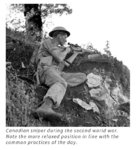
This picture for instance, is supposedly proof that soldiers had gotten lazy with shooting. Except the dude isn’t shooting. He is scanning in security.
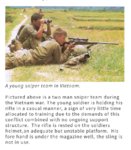
Same with this one. He isn’t shooting- he’s scanning. Notice all the other guys sitting out on the open, to say nothing of his spotter sitting right beside him. Read the caption- it is deliberately misleading. Any one that has been a sniper or actually understands it, would immediately know what those guys are doing. So either he doesn’t know the subject, or he is cherry picking pictures to form a false narrative.

Full stocked rifles (captured barrels) don’t have point of impact shifts when using a tight sling or when using a rest...? Absolute nonsense. They have POI shifts because the wood is touching the barrel.
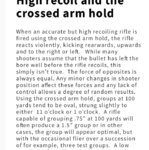
The rifle recoils up and to the right primarily because of poor body position (shown below), and secondarily because of poor stock design. For most the way to fix that is not by adding another couple of variables- sling tension and hand position/pressure. Adding those things to already poor body position and stock design causes all the issues that he’s trying to correct. Inconsistency, uneven torque and tension causing “flyers”.

So an 4’5” 11year old girl, a 40 year old 6’5” dude, and a 20 year old 5’2” woman have the exact same hand sizes and their fingers go in the exact the same position? Hand sizes vary, finger length vary, finger strength varries. It doesn’t matter what part of the finger is touching the trigger, only the the force is coming straight to the rear and the finger breaks at 90 degrees. Where that position is will be different for each person.
If POI is shifting between a sandbag and a pack, you have a problem. In this case because your adding uneven torque and tension with a sling.
So we add more variables (front and rear hand tension), along variable sling tension and wonder why there’s a POI shift? Is this repeatable for most people in the field.

While he is correct that ideally you want the full pad to have contact with the shoulder, putting the pad low in the shoulder generally comes from subconsciously moving the gun into a position where it smacks your cheek less. People revert to this on their own, and removing rifle fit, it’s because the gun jumps less during recoil. It jumps less because the deeper you get the pad in your shoulder, the lower the bore line is. Aka- correcting poor stock design. The more drop at heel the worse it is.

So there’s POI sifts from sandbag to backpack, now there’s POI shifts from pack to a hand between the pack? What else causes those shifts? If that’s the case, then how is someone ever going to hit anything if the slightest change in rests is causing misses?
The reason people are missing when using the front hand under the forend is due to inconsistency. They tighten or relax their hand during the shot (anticipation/flinch).
Con’t...
- Joined
- Oct 22, 2014
- Messages
- 9,904

Here he points out the issue.

Bipods require straight back, neutral recoil to work. The reason he can’t get optimum results is precisely because of his “technique”.
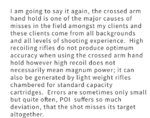
If you are missing due to a “crossed arm hand hold”, you have problems and a sling and forend hold isn’t going to correct that. Most people miss because they flinch, anticipate, and snatch the trigger. People miss seeing their impacts due to poor body position and poor stock/rifle design.
This-
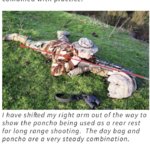
Are why all of those things are happening. He’s actually straighter behind the rifle in this picture than any other, but it’s the only one that’s from an above angle. That recoil line is out in space. Add the sling and the hand along with his angled body, and you literally have the angled rifle/bungee cord/trampoline setup.
- Joined
- Oct 22, 2014
- Messages
- 9,904
I have nothing personally against Nathan Foster, don’t know him, have never met him. His book and writings got a lot of traction for a while, but there is so much glaringly false or misunderstood in them, that it all has to be looked at with a jaundiced eye.
Similar threads
Featured Video
Stats
Latest Articles
-
Kryptek Traverse Merino Review
-
First Lite 308 Pant Review
-
Argali Selway 6P Tent Review
-
AGC Kobuk 2800 Backpack Review
-
Hunting The Leaf-off Window
-
TT#41 Jordan Budd’s Tips on Finding and Killing the Big One
-
NEMO Hornet Elite Osmo 1P Tent Review
-
Rokcast Reload: Stories from a Wall Tent
-
Vote No On Prop. 127
-
Marlon Holden: High Level Mule Deer Stalking

